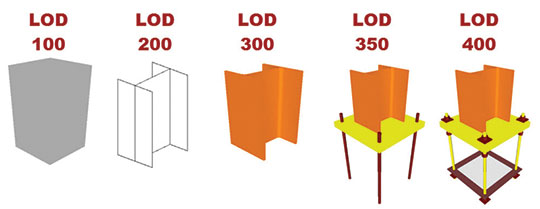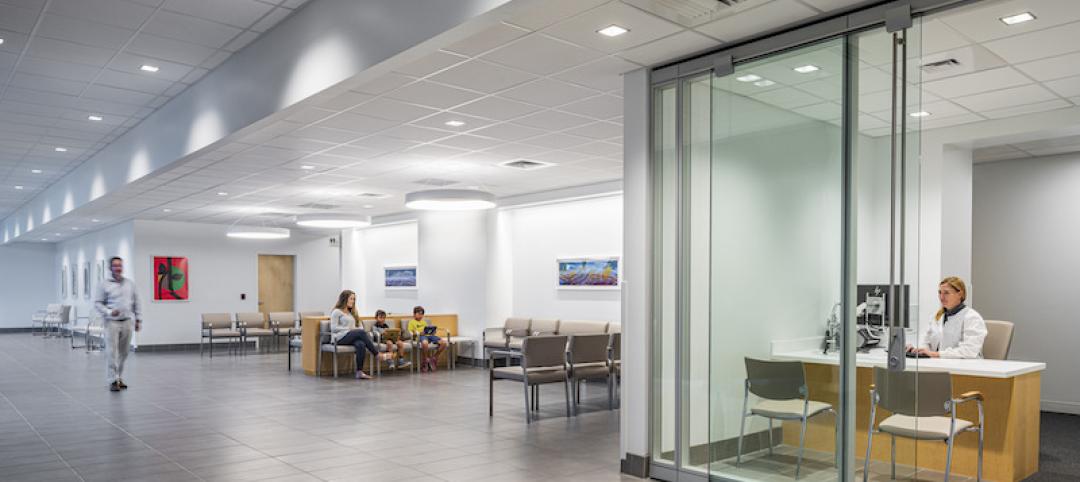Years ago, GS&P’s architects, engineers and interior designers started talking about the many benefits of transitioning from 2D modeling to 3D building information modeling (BIM).
These days, BIM is par for the course across most facets of design. But a lot of the conversation surrounding BIM still lacks clarity due to ambiguous terminology, a lack of clear-cut guiding illustrations and widely varying implementation. BIM is interpreted different ways by different people in different parts of the world, so it’s very important for designers and clients to get on the same page about deliverables. Let’s talk in more depth about where the challenges occur:
Terminology
You can’t talk about BIM without also talking about LOD. But wait, which one? There’s the LOD that means “level of detail” and the LOD that means “level of development.” They’re both legitimate concepts that are relevant to 3D design, so the fact that they share an acronym is problematic. The real challenge, though, is in deciphering their meanings.
Level of detail measures the amount of information a component should provide—it’s about quantity, not quality. A low level of detail means a designer must only indicate that an office chair exists. A higher level of detail means a designer should specify the chair’s width, height and model.
Level of detail eventually morphed into level of development, which is now the more commonly used term. It is meant to measure the quality of a model at five different levels: 100 through 500. Most BIM models in the U.S. are designed to Level 300, where “model elements are modeled as specific assemblies accurate in terms of quantity, size, shape, location, and orientation. Non-geometric information may also be attached to the model elements.”
To complicate matters, the United Kingdom and some other nations hardly use the “LOD” term at all. They instead use the BIM Maturity Diagram to illustrate various BIM maturity levels (0, 1, 2 and 3). Starting in the summer of 2012, the UK government began requiring that all projects implement a level 2 BIM at minimum. They also aspire for all BIM data be fully collaborative and electronic by 2016.
Practice
Definitions are fine and good. But the definitions within the AIA’s first BIM contract document—AIA E202 Building Information Modeling Protocol Exhibit – can be interpreted in very different ways, especially without any illustrations depicting what LOD 300 might look like in a plan. In August 2013, Building Design+Construction reported on frustrations with the vague E202 document:
“None of the LODs offered a graphical representation of what a model at that level would look like or detailed instructions for how to use models in each LOD for a variety of disciplines. The document, which the AIA has since updated and published as the AIA G202-2013 Project Building Information Modeling Protocol Form (June 2013), had no specific rules or requirements for exactly what’s in a model at each level. As a result, design firms, general contractors, and subcontractors have no idea exactly what they would be handing off or receiving by way of the BIM model.”
Since then, some progress has been made by way of a first-ever BIM deliverable document produced by a group of BIM users called BIMForum. Still, others are looking to different systems altogether for more guidance. Recently, one of GS&P’s international clients requested that we deliver our project designs using the RIBA Outline Plan of Work. RIBA stands for the Royal Institute of British Architects, and their Plan of Work clearly defines each of a project’s six major work stages (preparation, design, pre-construction, construction, use and R&D) and its associated tasks.
They have also developed a document called the BIM Overlay to the RIBA Outline Plan of Work, which details the BIM deliverables associated with each work stage. Documents like these help designers stay on track by providing the right amount of detail at the right times, and they also help eliminate confusion about deliverables. Which brings me to my next point…
Expectations
The biggest challenge created by the BIM confusion is managing and meeting client expectations. Without a shared perception of what LOD 300 looks like, for example, a designer can potentially under-deliver or over-deliver on what a client is expecting. Under-delivering might mean that the design documents aren’t detailed enough and don’t paint a vivid enough picture of what a space will look like. Over-delivering might mean that superfluous time and/or money is spent on generating unnecessary details. Neither is good; we want to hit the right mark on the first effort.
I hope that we can expect continued clarifications and more uniform documents to guide our BIM designs in the future. But as the industry is working toward that goal, it’s an excellent reminder of the importance of communication. A shared understanding of LODs between client and designer will certainly be aided by better definitions and illustrations, but those things can’t replace a good dialogue. Clear communication about expectations and deliverables should always be a top priority, and then the remaining details are better able to fall into place.
What challenges have you encountered with BIM and LOD? How have you overcome them?
About the Author
John Scannell is a Senior Mechanical Designer with more than 25 years of engineering design experience. He has worked the past 16 years with GS&P. His work has included the development of process piping, mechanical HVAC and structural BIM models along with supporting the layout of electrical and architectural drawings. John is responsible for managing the BIM models that are produced for the firm's Industrial market. More on Scannell.
Read more posts from the GS&P Dialogue blog.
More from Author
Gresham Smith | Aug 17, 2023
How to design for adaptive reuse: Don’t reinvent the wheel
Gresham Smith demonstrates the opportunities of adaptive reuse, specifically reusing empty big-box retail and malls, many of which sit unused or underutilized across the country.
Gresham Smith | May 24, 2023
Designing spaces that promote enrollment
Alyson Mandeville, Higher Education Practice Leader, argues that colleges and universities need to shift their business model—with the help of designers.
Gresham Smith | Apr 24, 2023
Smart savings: Commissioning for the hybrid workplace
Joe Crowe, Senior Mechanical Engineer, Gresham Smith, shares smart savings tips for facility managers and building owners of hybrid workplaces.
Gresham Smith | Mar 20, 2023
3 ways prefabrication doubles as a sustainability strategy
Corie Baker, AIA, shares three modular Gresham Smith projects that found sustainability benefits from the use of prefabrication.
Gresham Smith | Jan 19, 2023
Maximizing access for everyone: A closer look at universal design in healthcare facilities
Maria Sanchez, Interior Designer at Gresham Smith, shares how universal design bolsters empathy and equity in healthcare facilities.
Gresham Smith | Dec 20, 2022
Designing for a first-in-the-world proton therapy cancer treatment system
Gresham Smith begins designing four proton therapy vaults for a Flint, Mich., medical center.
Gresham Smith | Nov 21, 2022
An inside look at the airport industry's plan to develop a digital twin guidebook
Zoë Fisher, AIA explores how design strategies are changing the way we deliver and design projects in the post-pandemic world.
Gresham Smith | Feb 13, 2022
Helping maximize project dollars: Utility coordination 101
In this post, I take a look at the utility coordination services our Transportation group offers to our clients in an attempt to minimize delays and avoid unforeseen costs.
Gresham Smith | May 7, 2021
Private practice: Designing healthcare spaces that promote patient privacy
If a facility violates HIPAA rules, the penalty can be costly to both their reputation and wallet, with fines up to $250,000 depending on the severity.
Gresham Smith | Mar 4, 2021
Behavior mapping: Taking care of the caregivers through technology
Research suggests that the built environment may help reduce burnout.
















